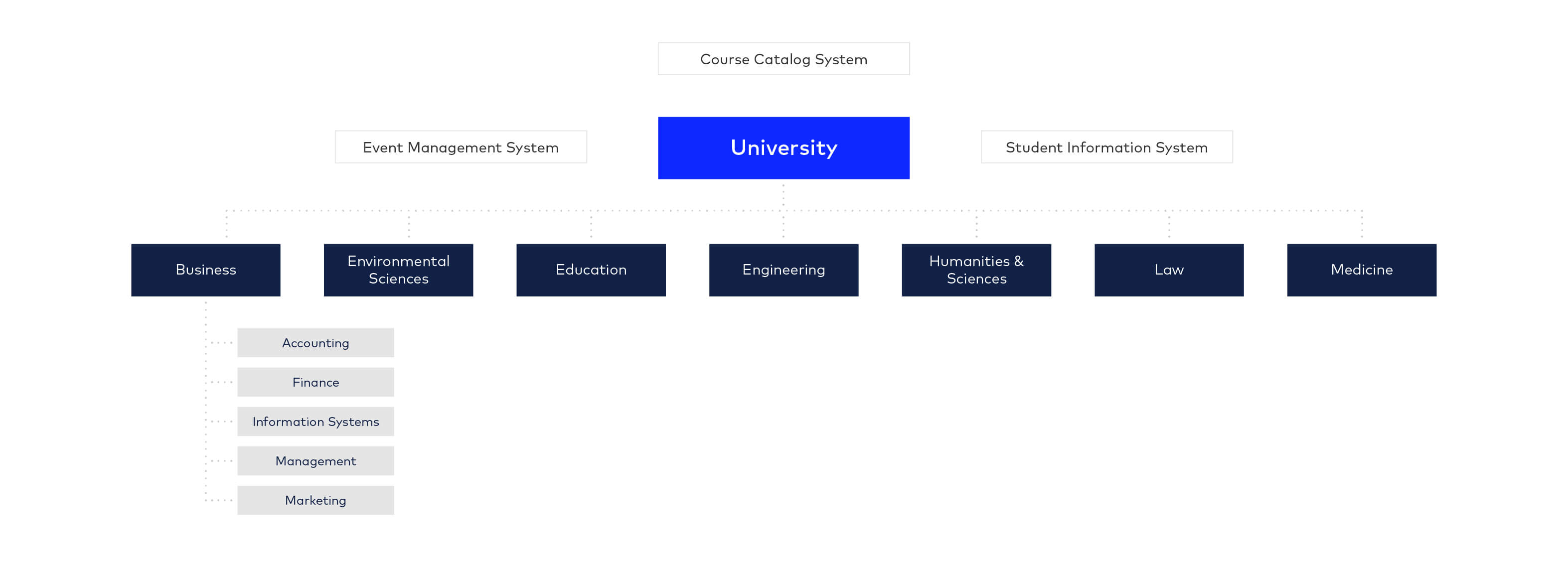Great Examples Of Distributed Content Management In Higher Education
With a multitude of colleges, schools, and departments to account for, distributed content management is an important part of an effective digital strategy for higher education institutions. This post covers three common use cases for universities.
In the first post in this series, What Is Distributed Content Management?, I defined two perspectives on that term: the distributed management of content and the management of distributed content. While doing so, I used the example of a large university and the need to consider both aspects of Distributed Content Management as part of an effective digital strategy for higher education. In today’s post I’ll develop that concept a bit further so we can discuss a few use cases in detail.
Setting The Scene
To ensure we’re all on the same page, imagine a large university. For fun, let’s call it “Drupal University.” Similar to many higher education institutions, the academic programs at Drupal University are split into multiple schools (let’s say 7) and each of those schools house a number of departments. Some of the smaller schools may only have 3 to 5 departments, but others, such as Humanities or the Medical School, may have upwards of 25. And let’s not forget that each of those departments is responsible for a number of different academic programs. Toss in the requisite assortment of research labs, student organizations and administrative departments - you can see how quickly our college’s web presence gets complex! At this scale we’re likely dealing with hundreds of different websites, all of which have requirements around content. It’s the perfect platform for Distributed Content Management! Let’s explore a few use cases that might pop up. Don’t worry, we’ll start with an easy one.

Use Case 1: Publishing Workflows For Individual Websites
For the web platform at Drupal University, this strategy is obvious. Unless they employ an absurdly enormous central communications team, large universities simply must distribute their content production. This doesn’t necessarily mean throwing open the gates! Consideration of a content approval workflow is a critical part of the content strategy for any organization that employs Distributed Content Management. Publishing workflows, whether manual or automated, must be tailored not only to the university, but to each school, department or group that’s in charge of a website. Content to be published on the undergrad admissions websites likely requires significantly more oversight than the blog of an 8-person research lab. The Medical School, with its 25 departments, probably has its own marketing and communications departments while a smaller school fights for the attention of centralized resources. This is definitely a case where one size doesn’t fit all.
Use Case 2: Sharing Content Out - Centralized Content On A Distributed Web Platform
Even the most decentralized universities have content that is centrally produced. In some cases it may be easiest to just hyperlink to that content in its original location; however, consider, a news story about a student winning a prestigious award. That story, produced by the Communications Department for the News section of the college’s main website, may be reposted in its entirety in numerous strategically advantageous places: the homepage of the student’s academic program, the websites for her research lab, a site run by Admissions, another targeted at alumni. Copying and pasting becomes a less efficient option the further content is distributed - more so when you consider the possibility of edits and possible unpublishing. In later blog posts, I’ll discuss some of the techniques and products organizations are using to efficiently share content across numerous websites.
Use Case 3: Sharing Content In - Decentralized Websites As Points Of Origin
Another interesting use case presents itself when we consider distributed websites as the starting point for content creation. Most universities maintain a central calendar of events, whether on a main website or in an Event Management System. In a well-formed distributed content model, with an an appropriate CMS like Drupal, the same metadata that allows visitors to filter events - audience, department, program, etc. - can be easily used to syndicate those events to various websites. Unfortunately, the same level of consideration is not always given to the publishing of new events. Because central event calendars feed information to the entire college, they are often protected systems, editable only by a subset of users with appropriate permissions. Content managers who are generally empowered to manage their own content may not have the same access to do so, or, in cases where they do have permission, find themselves needing to enter content into an entirely different system to get it published to their site. But why should this be the case? By extending the same technologies that allow websites to receive events from a central calendar, we can enable content managers to publish events to the calendar from within the same website they usually manage. (The same content approval and publishing workflow considerations apply, of course.)
Use Case 4: Integrating With Controlled Content Systems
At the far end of the Distributed Content Management spectrum are systems that need to publish consistent, controlled content to websites with no possibility for discrepancies across multiple sites. A common case of this in higher education would be a Course Catalog System (Acalog, SmartCatalog, CourseLeaf, etc.). One of the primary jobs of these systems is to integrate with the university’s Student Information System, providing the canonical description of a course, its contents, credits, costs, etc. If a university chooses to publish course descriptions on individual program sites, eliminating user error and neglect - mistakes made through copying and pasting, older content not being updated, etc. - is of great importance. As such, determining a strategy for directly integrating with these systems, rather than relying on a standard approach to decentralized content management, must be an important part of a university’s content strategy.
What’s Next?
In my next post I’ll continue exploring use cases for Distributed Content Management but switch our focus to the pharmaceutical industry.
